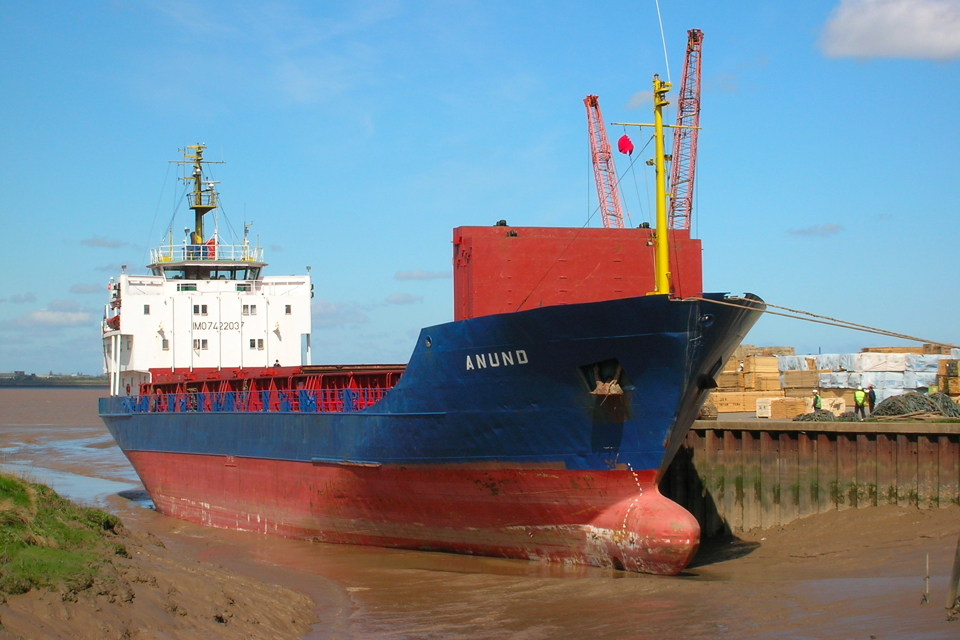When discharging and loading at low tide in ports, vessels can “ground” and suffer damage ‒ unless they are designed to handle this condition. To address this possibility, DNV GL has developed a new class notation in cooperation with Groot Ship Design that sets out easy to calculate structural integrity requirements.
The new class notation NAABSA provides a framework for ships to avoid damage when calling at ports with a high tidal range where they might fall dry during loading and discharging. Such ports include Bromborough, Greenwich and Glasgow in the UK, for example, or Rochefort and Les Sables-d’Olonne in France, and several ports in river estuaries in South America. A ship falling dry can result in costly ship bottom deformation if the ground is uneven.
The Safe Way to Fall Dry
Bottom damage is avoidable by designing the structure of a vessel appropriately when it is likely that it will call at such ports. From an economic viewpoint, this approach is preferable to reducing the payload ‒ and sacrificing income ‒ to avoid falling dry, or risking costly repairs.
Another key question is whether the bottom of the port is level enough to allow the ship to rest on it evenly. To date, the BIMCO charter clause “Not always afloat but safe aground” (NAABSA) has confirmed that a ship is allowed to moor at locations where the bottom of the harbour basin is safe (flat, homogenous and free of hard points) enough for the vessel to fall dry without suffering damage.
Aside from the BIMCO charter party contract, the requirements for NAABSA operations are mentioned in many building specifications. But many operators would like to see more specific provisions, not least because of insurance-related considerations, according to DNV GL.
New Class Notation
To get a comprehensive picture of what the industry needed, DNV GL consulted with owners and external ship designers before developing its new class notation NAABSA. ‘Generally speaking, reinforcing the bottom structure of a vessel is adding weight you cannot load as cargo, provided that all other parameters remain unchanged,’ explains Huib van der Pas, construction specialist at Groot Ship Design. The Dutch design firm specialises in medium-sized and smaller vessels. ‘It is important to strike a balance between reinforcements that provide a meaningful safety margin for NAABSA operation and adding unreasonable extra weight.’
The new class notation (DNV GL-RU-SHIP Pt. 6 Ch. 1 Sec. 13) spells out technical requirements regarding the reinforcement and structural integrity of ship bottoms, in particular the shell bottom, stiffeners, floors and longitudinal girders. Even ships not built according to the DNV GL rules can be checked to determine their fitness for the new NAABSA notation.
Conservative Assumptions
The pressure a ship’s bottom structure must withstand depends on a number of factors. DNV GL’s experts based their calculations for the NAABSA bottom pressure on conservative assumptions. In the scenario underlying these rules, the ship falls completely dry while touching the ground only with the flat portion of its bottom. The distance between longitudinal girders on the ship bottom must not exceed 4.5 metres, and ship length is limited to ninety metres.
However, these are only standard values; calculations can be adapted to the individual ship as required. ‘When calculating the bottom pressure, we followed the client requests and developed easy-to-use formulas and load assumptions. Experiences shared by customers have been very helpful in this respect,’ says Jan Rüde, Ship Type Expert MPV, Hull Structure and Outfitting at DNV GL.
Easy to Calculate
Implementing the new NAABSA rules in a newbuilding project requires knowledge, but is generally not too complicated, says Van der Pas, a result of the close cooperation between DNV GL and Groot Ship Design. ‘You apply the customary rules, but substitute the pressure you would use under the standard rules with the pressure to be taken into account for NAABSA,’ he explains.
‘This pressure value is easy to calculate, with only the displacement at full draft and the area of the flat bottom of the vessel needed as input quantities. Divide one by the other, apply a safety factor, and you are done. Compared to loads of other static and dynamic forces that have to be taken into account during structural design, this is trivial. For the designer, the time needed for NAABSA calculations hardly makes a difference when estimating the budget for basic structural design.’
Operational Considerations
The new rules exclusively specify structural integrity requirements for a ship’s hull. This allows owners to obtain the NAABSA class notation without having to meet a costly and impractical docking requirement after the first NAABSA operation. However, falling dry also can affect a vessel’s ability to fight fires and cool engines. Equipment such as thrusters, propellers and rudder can be affected as well. Such risks are addressed by a Guidance Note in the rules for the NAABSA class notation.
‘We consciously avoided including any additional requirements that go beyond verification of the structural integrity, leaving other aspects the responsibility of the owner,’ explains Rüde.
Picture by David Wright.








